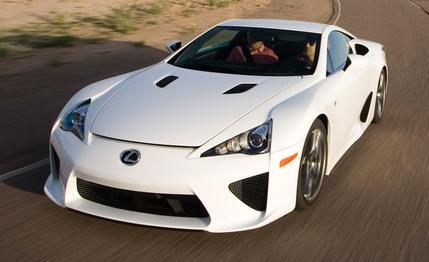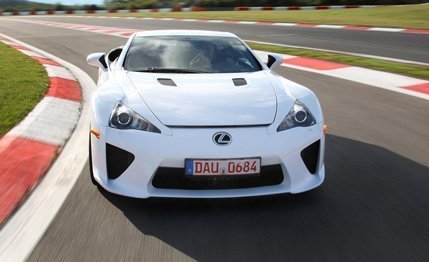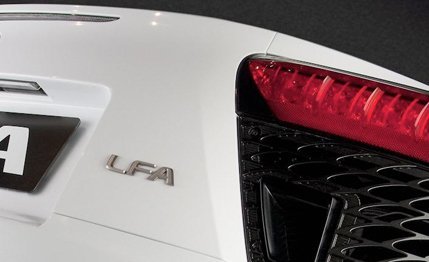 Instrumented Test
Instrumented Test
Finally, the yammering and chin pulling is over. It’s time to see if Lexus’s long-time-coming LFA supercar makes supercar numbers. We’ve strapped on the gear, we’ve burned the gas, and we’ve sorted the data. And as far as we know, we’re the first to have done so.
Proving that it still has plenty of budget, Lexus parent Toyota jetted one of the prototypes of the $375,000 carbon-fiber LFA across the Pacific, put it solo into an enormous truck with enough empty space to hold another six or eight LFAs, and hauled it to Arizona for us. Toyota’s own Phoenix-area proving ground being closed to visitors and especially closed to media, we went over to the Nissan Technical Center North America’s 3050-acre facility in Stanfield, Arizona, about 40 minutes south of Phoenix, where Nissan happily rents track time to anyone who’s paying.

There it was, as white as an angel’s underwear, the glossy carbon-fiber dash and steering wheel reflecting our curious faces like funhouse mirrors. Many of the 200 or so employees at Nissan, busy getting their new full-size work van ready for market, just stopped and stared.
“What’s…that…doing…here?”
It’s here to prove it has the Right Stuff.
Ducts, Scoops, and Flares? Check
One may argue the details, but the LFA has a seductive shape—wide, low, wind-swept, and perforated with important-looking vents and ducts. Flush panels hidden in the duct cutouts that form the top of the doors grant access to the cabin. The cockpit swallows you up like a hot dog in a leather and carbon-fiber bun. The dash, the upswept center console, and the door sills are high, the glass as minimal as possible.
Exotics often are characterized by their odd controls, and the LFA meets the test. The stalks controlling the single front wiper and the high-beam/turn indicators are as thin as cocktail straws. You select reverse by reaching forward to find an obscure button on the left side of the instrument binnacle. The switch for the very important electric parking brake is down by your right shin. Every one of the exposed cheese-head fasteners in the dash (and there are quite a few) has “Lexus” engraved on it. Certainly, for $375,000, you should expect something different, not Toyota parts-bin kit. Even the tires were exotic. They were marked Bridgestone but had no model name or DOT certification stamp. We couldn’t find anything on the LFA that looks as if it had come off a Camry or even an LS460, except the plastic hood release.

Twist the key to on—the key is the only old-fashioned thing about the LFA—and thumb the steering-wheel-mounted start button. The 553-hp, 4.8-liter V-10 lights with a burst of authority, a throat-clearing mini-explosion up to 2000 or so rpm, just as the engines do in Ferraris and Lamborghinis. As does a Lambo Gallardo, which also has a V-10, the LFA has a deeper, huskier, coarser voice than a Ferrari.
Computer animators went to work on the all-digital displays, apparently, after an all-nighter watching Transformers movies. The tach needle doesn’t just appear at startup; it organically grows out of the center like a mutant beanstalk. Put the car in sport mode, and the displays do a quickie switch-o, change-o to a sportier-looking dial—at least a high-res pixilated digital one. Information screens slide out from behind one another, and the centered tach slides left or right as needed. It’s all fluid and weirdly organic, and very cool.
Wham, Slam, Thank You, Ma’am
It was a steep learning curve, out there on the mile-long straightaway of Nissan’s big oval. The LFA didn’t come with an owner’s manual, so we needed some time to plumb its strange controls.
The single-clutch six-speed automated manual has four modes: automatic and wet, where shifting is done for you; normal, where shifting can also be done manually; and sport, where shifts are manual only. In addition to the modes, you can vary the shift speed and shock using a knob on the right side of the cluster. Lexus advised us to try the automatic and sport modes. Unsurprisingly, we found the car quickest in the manual sport mode with the shift speed on its fastest setting. But you don’t get full transmission control. Even in full-manual mode, the transmission upshifts for you at about 9200 rpm, 200 higher than redline.
At the moment, there’s no launch control on the rear-drive LFA, so we ran a few acceleration runs by just stomping on the throttle. The LFA hit 60 mph in about 4.4 seconds, about as quickly as a stock BMW M3 and not terribly impressive. So we tried an old trick from our high-school days: the neutral slam.